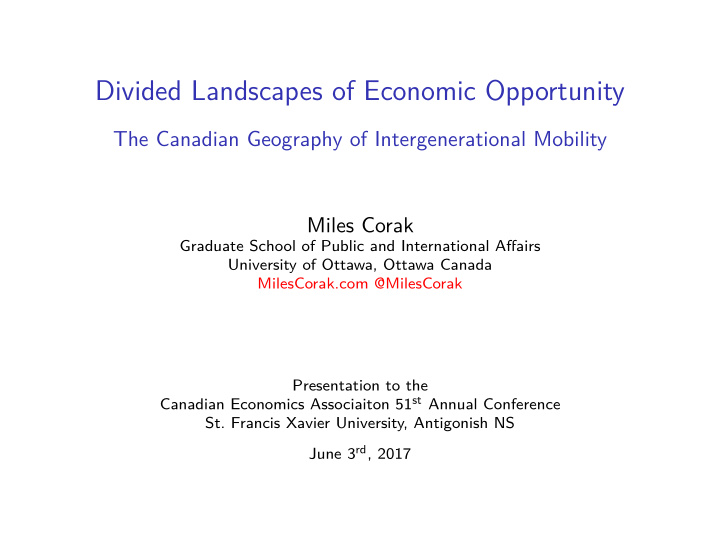



Divided Landscapes of Economic Opportunity The Canadian Geography of Intergenerational Mobility Miles Corak Graduate School of Public and International Affairs University of Ottawa, Ottawa Canada MilesCorak.com @MilesCorak Presentation to the Canadian Economics Associaiton 51 st Annual Conference St. Francis Xavier University, Antigonish NS June 3 rd , 2017
For children from almost all 266 Census Divisions, average adult income is higher than average parent income 70,000 Average income is higher for children 60,000 Average child adult income 50,000 40,000 30,000 20,000 Average income is higher for parents 10,000 10,000 20,000 30,000 40,000 50,000 60,000 70,000 Average parent income in each Census Division (2014 constant dollars)
Three measures of intergenerational mobility we care about 1. incomes lnY i , t = α j + β j lnY i , t − 1 + ε i , j average incomes of children from different communities vary for at least three statistical reasons related to differences in: ◮ absolute income mobility ( α j ): the overall change in average adult income of all children compared to the average of their parents ◮ relative income mobility ( β j ): how much the gap between parent incomes is closed in the next generation ◮ average community income ( ¯ Y t − 1 ): differences in the average parent incomes
The expected percentile rank of bottom half children varies across Census Divisions from less than 30 to over 50 60 Expected percentile rank of children 50 Canada 40 30 20 Expected percentile rank of children with parents in the bottom half 10 0 50 100 150 200 250 266 Census Divisions ordered from lowest to highest rank mobility for bottom half children
Three measures of intergenerational mobility we care about 1. incomes 2. position y i , t = a j + b j y i , t − 1 + ǫ i , j the average rank in the national income distribution of children from different communities depends upon: ◮ absolute rank mobility ( a j ): how much a child born to bottom ranking parents rises ◮ relative rank mobility ( b j ): how much the rank of a child increases for higher ranking parents
The intergenerational cycle of bottom income Probability of staying in the bottom quintile for men and women having bottom quintile parents 0.40 or higher 0.25 to 0.30 0.35 to 0.40 0.20 to 0.25 0.30 to 0.35 less than 0.20
Rags to riches mobility Probability of moving to the top quintile for men and women having bottom quintile parents 0.20 or more 0.05 to 0.10 0.15 to 0.20 0.025 to 0.05 0.10 to 0.15 less than 0.025
Three measures of intergenerational mobility we care about 1. incomes 2. position 3. upward mobility, avoiding poverty ◮ rags to riches ( P 1 , 5 ): moving to the top, given bottom income parents ◮ the cycle of poverty ( P 1 , 1 ): staying in the bottom, given bottom income parents ◮ the cycle of privilege ( P 5 , 5 ): staying in the top, given top income parents
Three measures of intergenerational mobility we care about 1. Income mobility Regression to the mean of incomes ◮ Absolute: α j least squares estimate of intercept ◮ Relative: β j least squares estimate of slope ◮ Average income: ¯ Y j average permanent income of parents 2. Rank Mobility Percentile rank-rank regression ◮ Absolute: a j least squares estimate of intercept ◮ Relative: b j least squares estimate of slope 3. Directional mobility Cells of qunitile transition matrix ◮ Rags to riches: P 1 , 5 conditional probability of top income ◮ Intergenerational low income: P 1 , 1 conditional probability of bottom income ◮ Intergenerational privilege: P 5 , 5 conditional probability of top income
Table 1: Average child and parent ‘family’ incomes by province Province/Territory Number of Children Child Income Parent Income Newfoundland and Labrador 84,050 45,900 29,400 Prince Edward Island 16,750 45,600 30,750 Nova Scotia 112,900 45,350 35,150 New Brunswick 91,500 44,200 32,850 Quebec 796,650 50,800 39,700 Ontario 1,057,550 57,950 44,250 Manitoba 122,150 48,550 36,500 Saskatchewan 122,500 56,550 39,750 Alberta 284,550 65,200 48,550 British Columbia 304,250 53,200 47,200 Yukon 2,950 50,700 42,450 Northwest Territories, Nunavut 7,150 46,100 29,050 Canada 3,002,950 54,500 42,050 Note: Numbers are weighted totals, incomes expressed in 2014 dollars, and everything rounded to the nearest 50.
Clustering communities with unsupervised machine learning 15 10 5 0
The landscape of “us and them”
Four divides in the landscape of economic opportunity Census Division Clusters (determined by Hierarchical Agglomorative Clustering) 1 2 3 4 unclassified
Correlates of economic opportunity Probability of intergenerational low income 0.50 0.45 0.40 0.35 0.30 Number of Children in bottom quintile families 50,000 0.25 10,000 1,000 0.20 5 10 15 20 25 30 35 40 Poverty rate in the parent's generation (Percent of population in the Census Division below the LICO)
Public policy for economic opportunity Demand side policy 1. The nature of growth and income security policy 2. Cities as poles of inclusive growth ◮ Toronto, no more? ◮ diversity of employment opportunities ◮ public goods and non monetary aspects of well-being Supply side policy 1. some First Nations communities 2. boys in lower income families 3. education 4. geographic mobility as human capital 5. immigration ◮ age at arrival ◮ access to jobs, implicit bias, TFW
Miles Corak University of Ottawa @MilesCorak The full paper and associated appendices are available MilesCorak.com/equality-of-opportunity
Recommend
More recommend